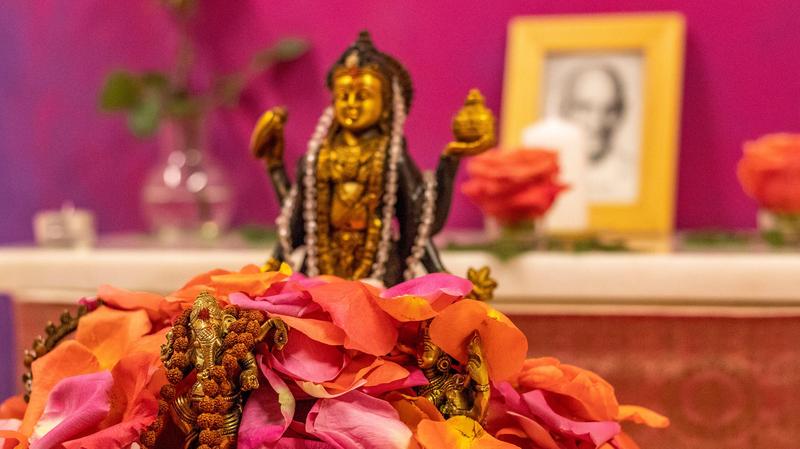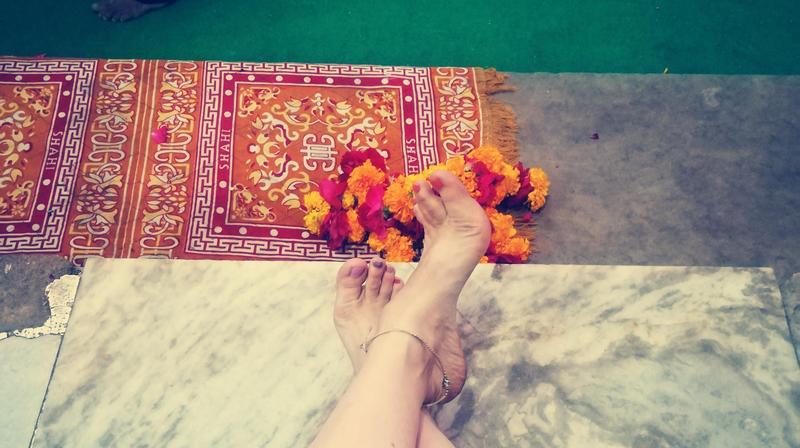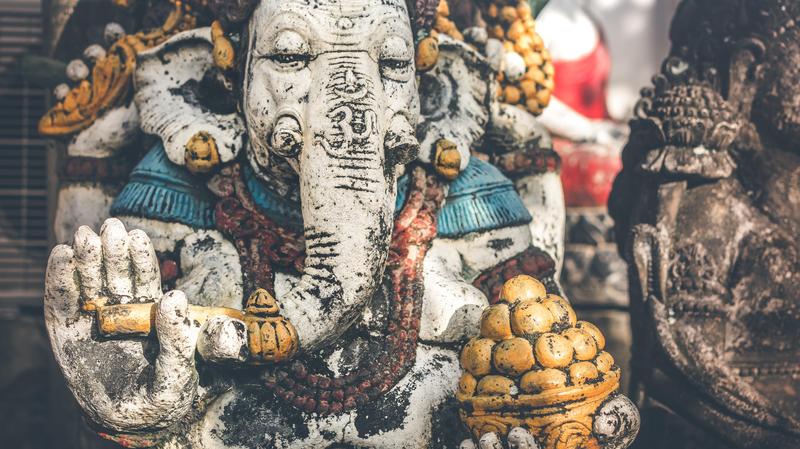Philosophy is the human attempt to understand the nature of the universe and the meaning of life. For the study of philosophy to flourish, a settled society where people need not struggle for bare existence is important. India is blessed with a good climate, fertile land, the protection of the Himalayas and an abundant rainy season.
Table of contents
- Introduction to Indian philosophy
- The three gunas - the qualities of nature
- How to keep your life in balance
Yamas: relating to other people
- Ahimsā: non-violence, refraining from doing injury, compassion
- Satya: truthfulness
- Asteya: Non-stealing
- Aparigraha: freedom of greed, non-possessivness
- Brahmacharya: non-dwelling of mind on sense object
- Swādyāya - spiritual self study; self-reflection
- Saucha - purification
- Tapas: austerity; self-discipline
- Ishwara-pranidhāna:surrender to the divine
- Santosha: contentment, satisfaction
- Learn more about the Indian philosophy in one of our seminars
Introduction to Indian philosophy
In many parts of the world, the reflection on the nature of existence is luxury of life. However, since ancient times, philosophy has held a prominent position in Indian society as the basis of all arts and sciences.
The Indian view of the universe is that it is dynamic and constantly transforming itself. This is in quite different from that of Western science, which seems to want to “freeze” reality.
Indian philosophy accepts:
- a cordial relationship between the human and Divine realms. God is not a tyrant, sitting up in heaven, who punishes you for your sins. Your karma (your own action) determines the reaction that you will get.
- The idea that what thought reveals is not opposed to reality, but part of it. Reality can be understood by intuition; the subjective “truth” is as important as objective truth. It is generally accepted that truth may be many sided and paradox is readily accepted.
- Each one of us, in essence, is pure – and can never be impure. Although you might identify with certain negative qualities, your essential nature remains pure. An analogy is that water may appear to be polluted, but actuality the water is simply carrying impurities.
Indian scriptures tend to be written in a way that is difficult for you to understand. The general consensus is that it is best to study them with a teacher. Yoga Vidya offers many excellent courses on Indian philosophy and various scriptures. In addition, you might want to consult the following books:
- "Ayurveda and Yoga" by Dr. David Frawley
- "The Yoga Tradition" by Dr. Georg Feuerstein
What is Yoga?
All life interconnected, integrated whole. When don’t experience that wholeness, feel isolated & dis-empowered.
Yoga means both experience of oneness, as well as practice by which attain that experience. Yoga is your progress & techniques for overcoming whatever obstacles may try to prevent that progress
“Yoga is the union of the individual psyche with the transcendental Self.” - Yoga-Yagnavalkya, 1.44
“Evenness of mind is called yoga.” - Bhagavad Gita, 2.48
“Yoga is skill in action.” - Bhagavad Gita, 2.50
“This is the real meaning of Yoga, the severance of union with pain and sorrow.” - Bhagavad Gita, 6.23
“yogas cittta vritti nirodhah” - “Yoga is the cessation, or the calming, of the mental modifications, i.e. the thoughts.” - Yoga Sutras of Patanjali, 1.2
“Yoga is ecstasy.” - Yoga Bhashya, 1.1
“Yoga is said to be the oneness of breath, mind and senses, and the abandonment of all states of existence.” - Maitri Upanisad, 6.25
“Yoga is said to be control.” - Brahmada Purana, 2.3.10.115
“Yoga is he separation of the Self from the World-Ground.” - Raja-Martanda, 1.1
“This they consider yoga: he steady holding of the senses.” - Katha Upanishad, 6.11
“Yoga, in a nutshell, is to keep the entire eternal and internal body clean, pure, sanctified, so that the mind flows without any barrier within and absorbs what goes on inside the body”. - B.K.S. Iyengar
“Yoga is the ability to direct the mind exclusively toward an object and sustain that direction without any distraction”. - T.K.V. Desikachar
“Yoga is the science which teaches us how to get direct experience of God”. - Swami Vivekananda
“I consider Yoga to be the oldest spiritual tradition in the world. The purpose of Yoga is to instil or to realize complete inner freedom. - Georg Feuerstein, Yoga Unveiled
A word about karma
The word “karma” has become a fashionable term that many people use with little understanding of its actual meaning. The Sanskrit word means “action”, and every action has an equal and opposite re-action. Karma has nothing to do with your destiny or fate – or with being punished for your sins. It doesn’t refer to luck – good or bad.
The principle of karma is simple: if you throw a ball against a wall, it will rebound with a force equal to the strength you used to throw it. If you think of this in terms of life in general, you will understand how your actions return to you.
Another way of summarising karma would be: as you sow, so shall you reap. If you plant an apple seed, you will get an apple tree. If you plant apple seeds, don’t complain because you would prefer to have cherries.
In yoga, do your practice and reap the rewards. Don’t resign yourself and think “I will not do anything”. It is impossible. You can’t live without doing action – even for a second. If you are not doing something positive with your life, the lack of activity will result in negative consequences.
An understanding of the ‘law’ of karma leads to your taking responsibility for your own actions. Don’t blame others when things aren’t going as you would like them to. If you want to change your life, change your actions. You always have a choice, but sometimes it takes time for your actions to manifest – so be patient, but keep at it.
Take some time to understand the philosophical basis of yoga. Then, in addition to asanas and pranayama you can begin to put them into practice in your own life.
Remember: success in your yoga practice is the result of six important qualifications. You need cheerfulness, perseverance, courage, knowledge gained from direct personal experience, firm belief in the teachings, and solitude.
The Three Gunas – the Qualities of Nature
According to yoga philosophy, everything consists of three ‘qualities’ or ‘gunas. These are the three strands which make up the rope by which Maya binds the individual self (the jjva) to this illusory world. Maya has no existence independent of the gunas. They are present in varying degrees in all objects gross or subtle, including the mind, intellect, and ego. The gunas operate at the physical, mental, and emotional levels.
"Purity, passion and inertia – these qualities, born of Nature, bind fast in the body, the embodied one, the indestructible." - Bhagavad Gita, 14.5
These three qualities exist throughout the universe, always together. There cannot be pure sattva without rajas and tamas, nor pure rajas without sattva and tamas, nor pure tamas without sattva and rajas. The difference between one being and another, lies in the various preponderances of the gunas. As long as you are attached to any of the gunas, you remain in bondage. Even the devas and angels are under their influence. The devas made up of a predominance of sattva, humans of rajas, and sub-human beings of tamas. Sattva binds a person with an attachment to happiness. Rajas binds with an attachment to activity, and tamas with an attachment to delusion. Yoga strives to go beyond nature and the gunas.
At the end of a cycle, when the universe is drawn back into a state of non-manifestation, the gunas are in a state of equilibrium. When, because of karmic factors, the equilibrium of the gunas is disturbed, they begin to assert their individual characteristics and the universe begins to manifest.
Sattva is the quality of light, purity and knowledge. In people it is characterized by cheerfulness, peace, contentment and devotion. There is no veiling, no agitations. You see a reflection of the Absolute, but it is only a reflection, that can be mistaken ‘real’ thing.
“Sattva which from its stainlessness, is luminous and healthy, binds by attachment to happiness and by attachment to knowledge.” - Bhagavad Gita, 14.6
Rajas is the quality passion, activity and motion, which is characterized by attachment to activity, and restlessness of mind. Rajas manifests as Maya’s projecting power (vikshepa-sakti), creating mental agitation which people experience as desires, passions, anger, envy, greed, jealousy, etc.
“Rajas is of the nature of passion, the source of thirst (for sensual enjoyment) and attachment; it binds the embodied one by attachment to action.” - Bhagavad Gita, 14.7
Tamas is the quality of darkness, impurity, inertia and laziness. As the veiling power of Maya, often making things appear other than they are, it manifests as ignorance, darkness, dullness, inertia, lethargy, laziness, and attachment to delusion.
Tamas manifests as Maya’s veiling power (svarana shakti), it is characterized by ignorance, dullness, lethargy and attachment to delusion.
“Know that Tamas is born of ignorance, deluding all embodied beings; it binds fast by heedlessness, indolence and sleep.” - Bhagavad Gita, 14.8
There is a well-known story that compares the gunas to three thieves who kidnap a person. Tamas wants to kill the victim. But, at the persuasion of Rajas, the second thief, he is tied up and relieved of his valuables. When the other two are asleep, Sattva, the third kidnapper, frees the victim and shows him the way home. Then Sattva takes his leave, he does not dare accompany the victim home, for fear of the police.
“The gunas define a person’s body-mind and create the illusion of the separate self. Rajas and tamas perpetuate the illusion of ego. Sattva creates the precondition of liberation. Hence the yogi seeks to cultivate the sattvic conditions and states.” - Georg Feuerstein, The Yoga Tradition
How to keep your life in balance: yamas and niyamas
“Cultivate the ground with Yama and Niyama, living morally and ethically because it is the only way to live, the only possibility if you seek spiritual growth”.
- Dr Swami Gitananda Giri
If you are like most people, you probably use between five and ten percent of your mental potential. If you already do yoga and/or have a meditation practice, you may have noticed that it has begun to awaken and enhance latent capacities within your personality. As these capacities continue to develop, you will most likely see your mind becoming more concentrated and more powerful. The ancient rishis (sages of India) were obviously aware that a concentrated mind is a strong mind. They recognised that there is a natural tendency for people with strong minds to control others with weaker minds. Unless you have unswerving spiritual integrity and discipline, the newly found powers of your mind can put powerful negative distractions into your path. A powerful mind, bereft of ethics and morals, can affect you and others adversely.
Patanjali begins his 8-limbed system with the “yamas” and “niyamas”, i.e. admonitions to practice truthfulness and non-violence; develop compassion; don’t steal; don’t be jealous; learn to control your energy and cravings. Simplify your life. Purify your mind and your environment; try to be content. Continue to study; never think that you have “mastered” yoga – and surrender your ego.
The yamas and niyamas are not harsh rules, but descriptions of human potential. As ethical guide-lines they offer you a way to live with heightened consciousness, integrity and joy.
Yamas suggest ways of establishing a healthy relationship to others, to society; they include positive attitudes towards life. These are ethical tenets with an outward aspect; they provide you with the guidance for mindful self-regulation when you interact with the world around you. The principles of ‘yama’ provide boundaries that can assist you in simplifying your life, creating peaceful interactions and in preserving your peace of mind.
Studying and attempting to practice the yamas, guides you in developing non-violent sensitivity (ahimsā), honesty (satya), non-stealing (asteya) , healthy intimacy (brahmacharya) and non-greediness/generosity (aparigraha) . These attitudes cannot be imposed upon you, nor can you develop them by merely imitating other people’s behaviour.
Niyamas address your relationship with yourself; observances with an inward-turned aspect. The niyamas focus on your obedience to the spiritual laws of yoga, self-discipline, and your attitude and relationship with yourself. They advocate positive means of self-empowerment by encouraging you to take full responsibility for your own actions. They consist of keeping yourself and your environment as pure as possible (śaucha), cultivating a sense of contentment (santosha), working to strengthen your mind and body (tapas), on-going study (swādhyāya) and a recognition that you are not separate from the Infinite (īshwara-pranidhāna).
Yamas
Ahimsā: non-violence, refraining from doing injury, compassion

Ahimsā-pratisthāyām tat-sannidhau vaira-tyāgah - When your mind is peaceful, hostility vanishes in your presence.
Patanjali’s Yoga Sutra, 2.35
By making ahimsa the first principle of the first limb (yama) of his eight-limbed system, Patānjali seems to be emphasising the importance of the practice. He does not debate the fact that violence can be an integral part of survival. As a human being, you are a combination of animalistic tendencies and divine inspiration. Your reactive mind (manas) is prone to acting instinctively and habitually. However, by using your higher mind (buddhi), you can choose whether or not you will respond to violence with violence. Unselfish love and compassion are expressions of your divine nature.
Ahimsā is more than non-injury; it is best expressed as positive, cosmic love. It includes forgiveness, gentleness and non-injury, whether physical, mental or emotional. Ahimsā stops you from doing harm with your thoughts, tongue or hands. When you practice yoga and meditation on a deep level, your goal is to transmute your basic aggressive nature.
To cultivate compassion, it is important to refine your awareness and develop clarity of vision. From pure visualisation, enlightened action arises. As a yogi, one of your ultimate goals is to see everything as your own Self. Patānjali suggests through the practice of ahimsa, you recognize the suffering of others and feel inspired to attempt to alleviate it.
Ahimsa is not passivity, nor is it cowardice. To practice ahimsa you may have to put up with insults, rebukes, criticisms and sometimes even assaults. Never retaliate nor wish to offend anybody even under extreme provocation. Don’t entertain negative thoughts against anybody nor harbour anger. Ahimsa is the perfection of forgiveness.
Satya: truthfulness, honesty
When you are firmly rooted in truthfulness, your actions accomplish their desired end.
- Patañjail’s Yoga Sūtra, 2.36 -
Satya entails your continued efforts to live your life in accordance with the highest spiritual values. As the second of Patanjali’s yamas (ethical guideline that suggest ways in which you, as a yoga practitioner, can best relate to other people), satya indicates truthfulness on all levels.
Satya involves approaching life without being bogged down by preconceptions that hinder your freedom. It means starting to get rid of some of the extraneous “baggage” that you probably carry around with you. It entails becoming more aware of how your perceptions may be inaccurate.
When tuning to the truth you attempt to speak, think and act in positive ways that are not hurtful to others or to yourself. Yet it is also vital to try to be as straightforward and sincere as possible. It might seem impractical or too difficult for you to always be truthful, but with practice, you will find that it gradually becomes easier. You begin to understand that non-violence, non-injury, purity, justice, harmony, forgiveness, and peace are all facets of the highest Truth.
Gandhi considered Truth to be the highest power in the Universe. His “Satyagraha” (meaning “the power of Truth”) is known in the West as the “passive resistance” movement. He realised that a truthful person is fearless and powerful. You have nothing to hide – from yourself or from others.
Some suggestions to help you to integrate the practice of satya into your daily life
- Begin to recognize how your fears and other negative emotions may prompt you to twist reality. Once you have understood this subtle process, your thoughts, speech and actions will start to realign themselves with each other.
- Think about how a regular meditation practice might improve your adherence to the principle of satya? Then meditate on a regular basis!
- Remember to keep your practice diary. See the attached sample; add a few other questions that could help you to adhere to satya.
- Be honest with your practice. Begin to notice how important it is to set an intention that is within your capability rather than something that you know is beyond you.
- Notice how the opportunity to practice satya arises every day.
Asteya: non-stealing

When non-stealing becomes firmly established, all wealth comes to the yogi.
- Yoga Sutra 2.37
Asteya: Non-stealing; refraining from taking what is not freely offered; considering what you really need and not letting your desires persuade you to take more
Asteya encourages you to be aware how many levels of stealing there may be. For example, a teacher may ‘steal’ from her students’ by not giving them opportunity to understand things for themselves or by providing too much information. Well-meaning, overly protective parents may ‘steal’ their children’s chances of becoming strong and free-spirited. An abusive adult may steal a child’s innocence. It is possible to steal time, especially if you are the type of person who always tend to arrive late – or a teacher who rarely finishes her class on time. You can also mis-appropriate affection, space, credit/praise, ideas, energy, trust, independence and free-will, among other things.
Many people, who wouldn’t consider shoplifting, would not hesitate to take a few pens from work, or aren’t entirely forthcoming on their tax returns. Stealing comes from a sense of entitlement, i.e. a feeling or belief that you deserve something that you haven’t actually earned.
As with the other yamas, asteya may be interpreted as both an individual and a collective value. With a view to connecting with the principle of asteya, take an honest look at how you live. Is yours a life of over-consumption that steals from the earth? Although asteya literally means "non-stealing" it can also be interpreted as not taking on more than you can handle, whether it is material expenditure or consumption of time and energy.
Some people steal when their bellies are empty. Others steal for psychological reasons, when their hearts are empty. There is also the stealing that comes from feeling spiritually empty or incomplete. When you compare yourself with others, you may feel inadequate and want what others have in physical ability, beauty, youth, material wealth, fame, power, love or spiritual attainment. This may constitute an act of psychological stealing.
When you move beyond the satisfaction of needs to the fulfilment of wants, you enter the realm of stealing. Yet, “needs” and “wants” are very subjective. People's needs vary in different climates, work and living situations. Needs change with time, season and age. Yoga practice enables you to quiet your mind so that you can listen deeply to what your own body, mind and soul truly need.
Aparigraha: freedom from greed; not desiring more than you need

When you are free of greed, you understand the purpose of your life and are aware of your past lives.
Patanjali’s Yoga Sutra 2.39
Aparigraha: freedom from greed, avarice and covetousness; deep generosity; non-possessiveness, non-hoarding, not desiring more than you need; neutralising the desire to acquire and hoard wealth; non-acceptance of gifts/bribes; not appropriating what is not freely offered
Modern people are routinely hit with sales barrages. Daily emails try to tempt you with the “free” shipping of gifts and TV ads try to convince you that spending money = loving your friends and family.
Maybe this is the perfect time for you to begin to integrate the principle of “aparigraha” into your daily life. Patanjali’s fifth “yama” (ethical ways of relating to the world around you) is usually interpreted to mean non-greed and lack of attachment to material objects. It may be more helpful to your spiritual practice to view aparigraha as the ability to be happy without the desire for excessive possessions. It is living simply without a surplus of possessions, sharing what you have, not judging others by their material possessions, and not believing that what you own is tantamount to who you are.
Aparigraha is the highest form of non-attachment or detachment. Some yogis consider this principle to be the key to all the others. Many see it as the most subtle and most difficult of Patanjali’s ten ethical guidelines to master. Aparigraha can be viewed as going against many of the principles of western consumerism.
Aparigraha enables you to let go of the fear and clinging associated with trying to protect what you own, or protect yourself against loss. This yama, perhaps more than any of the others, has a profound effect on your happiness. In yoga philosophy, all suffering is seen as being caused by a real or imagined loss. When you overly cling to someone or something, you tend to suffer.
When you invest your possessions with emotional meaning, you tend to starve yourself of what you most need, i.e. authentic deep relationships. As a yoga practitioner, you may be beginning to understand that when you yearn for ‘things’, you are, in fact, yearning for a closer connection to your true self and to the divine. The well-known American yoga teacher, Erich Schiffman, states aparigraha in a very positive way: "love is what is left when we let go of everything we don't need."
Aparigraha can also refer to ‘acquiring’ people as well. If you are emotionally needy, you may find yourself running from one person to another, always seeking a new friend, a better partner: a prettier one, a funnier one, a more successful one. This is a painful form of grasping, as it reduces people to objects that you can acquire and/or discard. It stimulates feelings of alienation and anxiety, as with each interaction you tend to become more distant from your true self and less able to experience the real joy of friendship.
Another subtle form of grasping is self-doubt and self-hatred. How often do you find yourself thinking: if only I could master some new fancy pretzel-asana … If only I weren't so timid, so clumsy, so fat…. These feelings reflect your attachment to negative concepts. You may be using what looks like ‘yoga’ to destroy yourself in a greedy attempt to be somehow better, to be someone you’re not.
Perhaps it would be best to frequently remind yourself that the purpose of meditation, and all yoga practice, is to help you to free yourself from the bonds of your mind. A greedy person will always experience many obstacles to meditation.
Brahmacharya: non-dwelling of mind on sense objects

“When you are able to be moderate, you will find knowledge and strength flowing to you”.
- Patanjali’sYoga Sutra, 2.38
Brahmacharya: control of passions; moderation; abstaining from excessive indulgences that waste your energy
The literal translation of the word ‘brahmacharya’ is the ‘path to Brahman’ (the Absolute). In its richest sense, brahmacharya represents training your mind to refrain from excessive dwelling on sense objects. It involves resisting the outward and downward pulls of sensuality that may disturb your spiritual practice. In the deepest sense, brahmacharya is also the transcending body-consciousness.
The practice of brahmacharya helps you to create a harmonious relationship among the different manifestations of energy in your body: emotional, sensual, sexual, physical and the more subtle levels of thought. With the practice of brahmacharya you consciously transform your physical energy (ojas) into spiritual brilliance (tejas).
Many modern students have trouble relating to the simplistic interpretation of brahmacharya as celibacy. But, brahmacharya is not about repression; it suggests sublimation. Rather than permitting your energy to be wasted or to become stagnant, you consciously direct it towards positive endeavors. Yoga texts prescribe total abstinence only for an extremely small number of people who are swamis, monks or nuns. For most people, the principle of brahmacharya refers to the art of self-control and moderation.
Brahmacharya may be seen as nurturing a healthy respect for yourself and your partner(s). It is also refraining from meaningless sexual encounters that deplete your energy. With practice, you find that, instead of feeling tired and drained, you have the energy necessary to control your own mind.
For yogis, reducing or being more moderate in your sexual activity is not a question of morality, but of energy control. If you discharge too much energy through sexual and sensual indulgences, you may not have sufficient energy to attain success in your spiritual endeavors. Without sufficient self-control, it is extremely difficult to progress in meditation.
If you are a glutton or epicurean, you are not practising brahmacharya, even if you are abstaining from overt sexual activity. This is also true if you are a person who waste their time and energy in needless talk and gossip. Through the practice of brahmacharya, you can begin to control your energies and channel them in more positive directions.
Some suggestions for integrating the practice of brahmacharya into your daily life:
- Examine your beliefs and values regarding the role of healthy sexuality in your life. Notice whether they tend to be puritanical, hedonistic or more balanced.
- Become more aware of how much your attitudes to sexuality are influenced by advertising and other media.
- If you have a partner, examine together the concept of moderation in your relationship. If you do not have a partner, choose a good friend to have this discussion with.
- Refrain from gossip!!
- Notice what you tend to do to excess, whether it is talking, eating, watching TV, sleeping or your sexual pursuits. Choose one of your excesses and try to be more moderate in it
Suggested further reading:
- Yoga and Ayurveda by Dr David Frawley
- The Practice of Brahmacharya by Swami Sivananda
Niyamas
Swādyāya - spiritual self-study

From self-study and reflection on sacred words, you are able to connect with the underlying natural reality.
- Patanjali’s Yoga Sūtra 2.44
Swādyāya can be interpreted to mean that you study by yourself, i.e. that you read about meditation, yoga or other aspects of spiritual life. Regular study is important because if you only practice, there is the tendency to forget why you are practicing.
Personal study not only provides you with the inspiration to practice, it also enables you to better focus yourself on a regular basis. Study of spiritual texts helps prevent your mind from being overly influenced by negative forces. It assists you in resisting distractions and defending yourself against the lure of your senses.
Swami Sivananda used to tell students that “an ounce of practice is worth a tonne of theory”. Yet, he never said that theory is unimportant. Swādyāya enables you to supply yourself with the necessary motivation to develop an inspired yoga practice.
Swādyāya works best when you practice without pre-conceived ideas and prejudices. By approaching the teachings of yoga in the spirit of right inquiry (vichara), at the right time and in the right place, you make it possible for a deep and long-lasting change to take place within your being.
Swādyāya goes beyond the intellectual gathering of information to include regular study and contemplation on how you can apply wisdom teachings to your life. It is not enough to simply have an intellectual, conceptual grasp of the ideas associated with the yoga tradition. You must also be willing to integrate those concepts into your daily life.
Some suggestions for integrating the practice of swādyāya into daily life:
- Dedicate some time each day to reading and studying spiritual texts – actually schedule the time into your agenda. Notice the effect this study has on your yoga practice – and on your life in general.
- Map out a programme of study for the year.
- Choose some spiritual texts, inspirational readings and/or poems to read. Studying does not mean just scanning the pages; it entails trying to understand every word, studying with your heart. The more you read, the more deeply you will find yourself beginning to see things in a new light. Swādyāya implies elevating your mind and expanding its horizons.
- Keep a weekly practice diary
- Begin a list of “spiritual books to read”
- Start working with a Journal:
Below are some suggested questions that relate to the practice of swādyāya. Choose one question at a time to work with; begin by writing it at the top of a new page in your journal. Each morning, sit and write for at least 10 minutes (preferably after meditation).- What in my life has led me to this point?
- What pre-conceived ideas or patterns of behaviour might be blocking me in my spiritual practice? How might I best let go of them?
- What is it that I hope to achieve through my spiritual practice?
- Where do I hope to be by the end of this year?
- What have I learned about myself from being a silent witness to my own thoughts and actions?
- What negative emotions tend to surface most frequently? Instead of repressing them again, how could I channel them into a positive direction?

When Patanjali speaks of swādyāya, he is referring not only to the reading of spiritual texts, but also the practice of japa (repetition of a mantra).
People who have not worked intensively with the practice of japa often scoff at it; you may perceive it to be mechanical to “just repeat the same word over and over again”. However, if you watch your mind, you may notice it jumping between scraps of songs you have heard, people you have seen and would like to see, thoughts about the weather, the soup you ate for lunch, a perceived insult by a stranger on the street and many other unrelated thoughts. Most people do little to control this reverie – so their minds tend to remain conditioned by external circumstances. Japa focuses your mind and fills it with positive sound energy.
Saucha- physical and mental purification; cleanliness

Senses, one-pointed-ness and fitness for Self-Realisation.
- Patanjali’s Yoga Sutra 2.41 -
Śaucha represents purification on all levels. It includes the physical cleanliness of bathing your body, maintaining an orderly home, eating healthy food and drinking clean water. It is also mental clarity, as well as speech that refrains from emotionally-charged obsessions and addictions. Śaucha enables you to find balance in your life.
Without purity in your body and mind, clarity will tend to elude you. The immensity and luminosity of your true self and your connection to spirit and to others becomes clouded. The transparency you cultivate by the practice of śaucha enables you to reflect the divine more completely in all your relationships. It is worth the effort to find time each day to enhance your practice of śaucha and to express gratitude for your ability to do so.
Through śaucha, your body, thoughts and emotions become clear reflections of your inner self. You begin to realise that happiness comes from within, rather than relying on external objects and circumstances.
Simplicity facilitates śaucha – keeping things as uncomplicated as possible enhances your ability to ‘cleanse’ the various aspects of your life, including your environment, actions, emotions, thoughts and, attitudes. It enables your mind, spirit and body to not feel overly attached, cluttered or complicated.
The condition of the space you live and work in has a direct connection to the quality of your health, well-being and inner peace. The state of your home and work area tend to reflect the state of your mind. Clear one and the other usually follows naturally.
Some suggestions for integrating the practice of śaucha into your daily life:
- Make a list of the things that are necessary in your life – also write a supplemental list of the things that you could put on the back burner for a while. At the end of the week, review your list. Use this as your starting point in determining ways that you might simplify your life.
- Keep the energy flowing smoothly within your environment. Don’t let things pile up – whether it is dirty dishes, laundry, unread magazines, unanswered mail or garbage.
- Think of ways in which you could simplify your life – then act on it. For example, walking or biking to work – or driving an eco-friendly car – is one way to not pollute the environment or your physical body.
- Begin to de-clutter your living space by preparing a bag for the charity shop. Every day, put one item into it. When the bag is full, drop it off at the charity shop and prepare another bag.
- Cleanliness and order contribute to lifting your self-esteem. They reinforce the awareness that you are worthy of good experiences.
- Make a resolve to straighten your desk/ kitchen/ work area each day before you leave it.
- Observe how your surroundings can make your mind feel clear and transparent – or the opposite. Observe the state of your mind when you are walking in a park or on a beach. Compare this with an observation of the state of your mind when you are standing on a crowded train or driving in congested traffic.
- Keep plants indoors: Having plants indoors increases oxygen production and purifies your air. It also increases the concentration of readily available prana for you to absorb.
- Start a Journal. Choose one or more of the following questions to work with. Write each question at the top of a separate page in your journal. Each morning, sit for at least 10 minutes and write down whatever comes to mind – don’t be your own editor – just write! If you have a meditation practice, it is best to sit just after you have finished your meditation.
- What do my home and work area say about the state of my mind”?
- How do I relate to my body?
- Do I actually experience my body as the temple of my soul?
Tapas: austerity; self-discipline; asceticism

When you practice austerities, you destroy the impurities within your body and mind.
- Patanjali’s Yoga Sutra 2.43 -
The practice of tapas purifies and strengthens your mind. It revolves around your determination to do something that is particularly difficult for you in order to develop your spiritual progress. Your goal is to make your mind stronger so that it can more easily focus and meditate.
The word ‘tapas’ comes from the Sanskrit word meaning “to heat” or “to glow”. In ancient times, all yogis were referred to as “tapasvins”, meaning people who do tapas.
If you want to make your arm muscles stronger, you might start lifting weights. If you lifted one kilo a hundred times daily, the exercise would become easier. At that point, you would probably progress to lifting two kilos, gradually increasing the amount of weight that you lift. In this way, you give your muscles something that is a little difficult for them, though not so difficult that they are able to do it.
If you try to lift five hundred kilos, you probably won’t be able to do it. If you give your muscles something that is too difficult, they won’t become stronger – they would not have the opportunity to develop. But if you give them something that is a little difficult, your muscles strengthen gradually. It is the same with your mind. When attempting to make your mind stronger, it is best to give it something to do that is a little difficult. For example, if you are a person who loves to talk, a powerful tapas might be to practice mouna (silence) for an hour daily.
For a shy person, the easiest thing is to keep silent. You are not really doing it as a spiritual practice. Actually, practicing mouna may be the least appropriate sadhana for a shy person. The best spiritual practice for them would be to aim at overcoming their shyness.
Other people like to talk and indulge in gossip. Their minds crave this constant entertainment; it’s a weakness of the mind. If your mind is like this, it might be a good sadhana (spiritual practice) for you to practice mouna to make your mind stronger.
Whatever weakness your mind has, tapas means doing the opposite. Try to do whatever is difficult for you, instead of glorifying your own weakness.
If it is difficult to sing in public, then sing! It is not that you think that you are going to become a great singer.
You do it because it is difficult for you to do.
- Each week, choose something that is a bit difficult that you are determined to accomplish. At the end of the week, look at how successful you were - what did you learn from your tapas?
- Choose a fear that you would like to face and/or overcome. This could include doing something such as singing in public. Or it could be asking a question when you feel shy, but know you should speak.
Ishwara-pranidhāna: surrender to the divine

self-surrender; self-surrender; non-attachment to your ego; surrender to the divine; going beyond your self-imposed limitations
Only when you completely surrender your ego will it be possible for you to attain samadhi.
- Patanjali’s Yoga Sutra, 2.45 -
The crowning jewel of your yoga practice is your ability to surrender. Without ishwara-pranidhana, you may find that you practise for a long time, seem to make great strides, but still feel that you are not totally happy and peaceful within yourself. When the realisation comes that it is not possible to reach the goal using only your own strength, it is the time to turn to a higher source for guidance.
The last of the five niyamas is yoga’s greatest challenge. Ishwara-pranidhāna consists of letting go of your embedded persona – what is known in Sanskrit as asmitā (see YS verse 1.17). Here Patanjali is inviting you to broaden your definition of ‘self’. He is reminding you that by defining yourself as an individual, you have come to believe that you are separate from the divine Absolute.
As long as you have a body and a mind, you must have an ego (a sense of self-awareness) to hold them together. This is the line you have drawn to identify who you think “I am” so that you can function in this world. If you want to have a universal experience, you will need to transcend that barrier. In meditation you strive to get rid of the ego and experience the Oneness of existence.
Begin by looking at how your world is very much created by your thoughts. Tell yourself that you are weak, and you will find yourself lacking sufficient strength. Or if you focus on an emotional experience, such as grief, it could begin to form an integral part of your personality. See how you mould your character by your thoughts. The more you hold on to negativity, the more it controls you.
- Choose a limitation that you seem to have. For example, you may think that you could never stand up and speak in front of a group. Realising that your fear or limitation is just a mental creation, try to go beyond it. Surrender your ego-imposed boundary.
- Each day, try to do something that you are fearful of doing, or something that you are afraid you might not be able to do properly (such as singing – especially in public). Do it anyway!! Don’t be reckless, but face your fears and overcome your self-imposed limitations.
- Think of a negative quality that you possess and make the determination that you will work on releasing. But, instead of focusing on the negative, think of the opposite, i.e. the positive. For instance, if your negative quality is impatience, focus on developing patience.
Watch your mind throughout the day and make a mental note of every time that you feel impatient. Then, instead of fighting the negative quality, just let go of it. Do this through introspection and a regular practice of mind-strengthening exercises. For example: make a determination that every time you notice yourself being impatient, you will do an additional round of alternate-nostril breathing before meditation. This will strengthen your connection to the positive, while helping you to surrender your attachment to your negative qualities.
Most important: let go of envy, which feeds your discontent by constant comparison with others. Do you delight in the suffering or lack of success in others? In German, this is called “Schadenfreude”, i.e. delight in another’s failure or defeat. Envy will never allow you to enjoy contentment.
Santosha: contentment; satisfaction; being peaceful in the present moment

From contentment comes supreme happiness. As a result of contentment, you gain unexcelled joy.
- Patañjali’s Yoga Sutra 2.42 -
Santosha is the optimistic state of mental well-being in which you attempt to focus on the positive aspects of all situations and all beings. It is a dynamic and constructive attitude that helps you to look at things in a new light. Contentment brings with it great inner joy and serenity. Your thoughts become steady and peaceful; you are more able to concentrate on your practice by being in the present moment.
Perhaps you have noticed yourself saying or thinking things such as “I should have done that yesterday”; “I wish I had started doing asanas when I was twenty”; “I could I had bought that house ten years ago when the price was low”; “Oops, sorry I said that”. But, yesterday is gone. Even if you think “I should have left five minutes ago”, you are late. There is nothing you can do to change the past. The past is past. Once you have said something, you can’t really take it back. It is a waste of your energy to continually be thinking of ways to change the past – or even the present. By the time you realise what is happening, it is already past. Only the future can be changed.
Santosha means living in the present moment. It is not forgetting about the past, but learning from it and being peaceful in the ever-present “NOW”. It is the ability to transcend the mental babble of “I could have done that” or “I should have done it differently” or “I would have done it, if only ….”
Notice how frequently your mind is restless on account of its desires for new experiences, new tastes in food or new acquisitions that you may not even really need. On account of this, you may experience yourself being burned by an internal yearning that consumes your energy slowly but surely.
Swami Sivananda speaks about “four sentinels who guard the domain of moksha (liberation). They are Shanti (peace), Santosha, Satsanga (company of the wise) and Vichara (right inquiry).” By befriending one of these guards, you find yourself in the company of all of them. Your life and sadhana will take an upward turn.
Understanding and practicing santosh can be a liberating experience. It endows you with practical methods to stop wasting precious energy on things you cannot change. It can enable you to focus on positive improvements in your life and help you to understand how you can best use your energies.
Begin to develop the habit of being a silent witness. Watch your own mind as though you are sitting in a cafe and engaging in a bit of people-watching. Observe your emotions, sorrows and joys, but try to not identify with them.
Suggested further reading: The Power of Now by Eckhard Tolle
Conditions of participation
Yoga Vidya is a non-profit association and Europe's leading provider of education and training in yoga, meditation, Ayurveda, massage, holistic health and spirituality.



